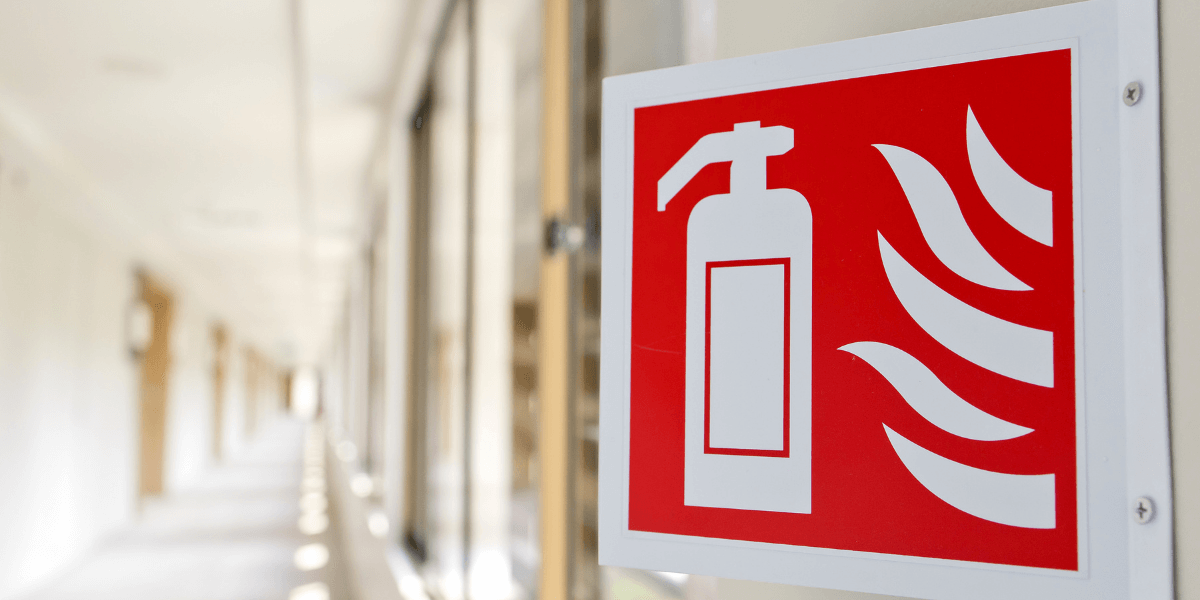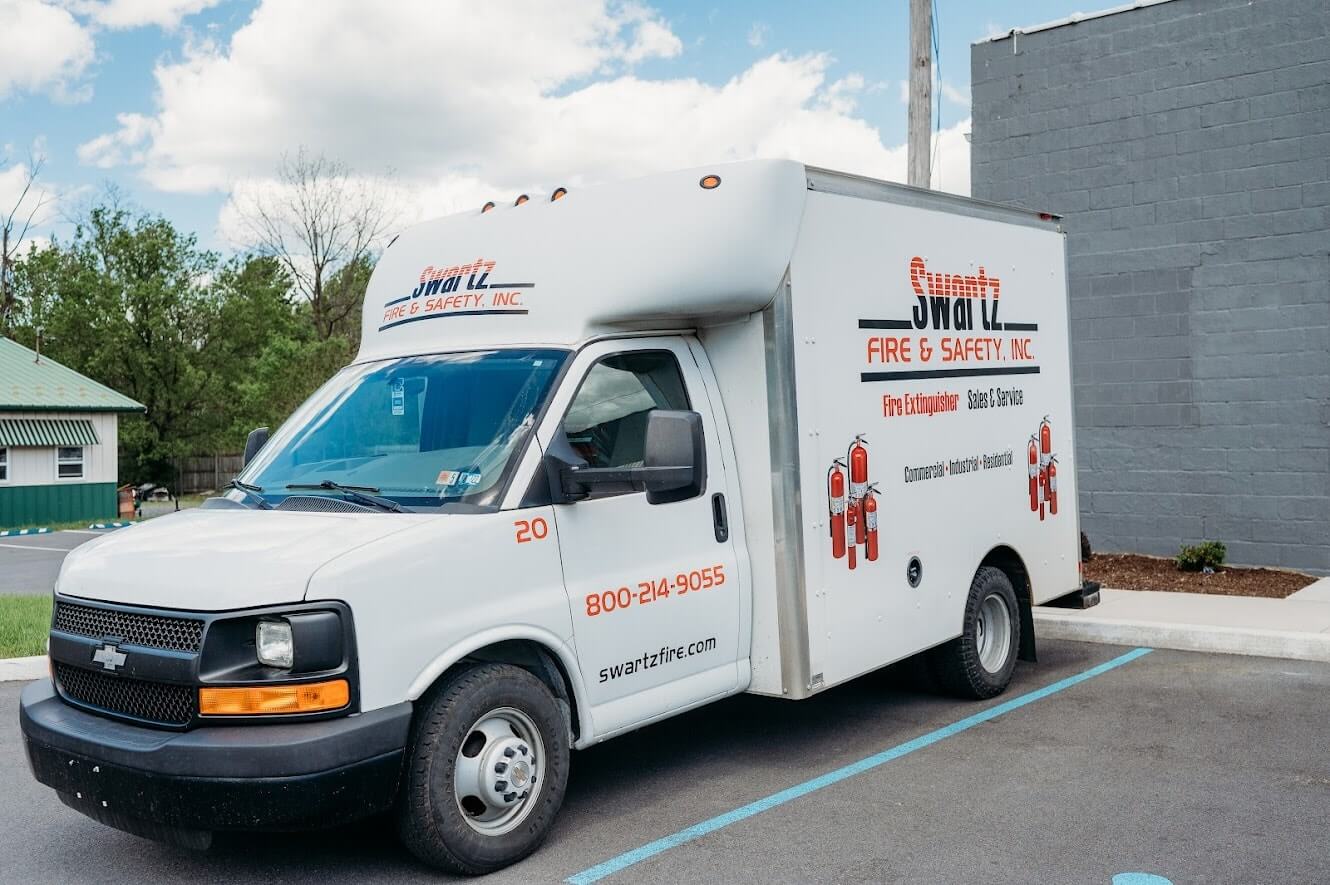Types of Fire Extinguishers and Their Uses: Which One Fits Your Risk?

Fires come in many forms, and they vary from grease splatters in the kitchen to electrical faults in the garage. Your knowledge about the types of fire extinguishers and their uses ensures you tackle small blazes with the right tool before they turn destructive.
Swartz Fire & Safety, serving Central Pennsylvania for over 35 years, offers this concise guide so you can match the right fire extinguisher to each hazard and keep your home or business protected.
Key Takeaways
- Matching each extinguisher agent to its fire class ensures effective suppression and minimizes property damage.
- Strategic placement and clear label reading let you grab the correct extinguisher in seconds.
- Monthly checks and professional inspections keep portable fire extinguishers ready for any hazard.
Fire Classes & Extinguisher Agents
Knowing the types of fire extinguishers and their uses starts with matching the fire class to the right extinguishing agent. Fires behave differently depending on what’s burning—wood, oil, electrical gear, metal shavings, or cooking fats—so picking the correct fire extinguisher can mean the difference between a quick stop and a job that gets out of control.
Fire classes overview
- Class A (Ordinary combustibles): Fires involving wood, paper, cloth, or other common combustible material—think piles of brush or paper in your basement.
- Class B (Flammable liquids & gases): Fires involving flammable liquids like oil, gasoline, solvents, or animal oils and flammable gases in confined spaces.
- Class C (Electrical fires): Fires fueled by energized electrical equipment—anything from power tools to server racks.
- Class D (Combustible metals): Fires involving metals such as magnesium, sodium, or titanium—most often found in workshops or labs.
- Class K (Cooking oil fires): High-heat grease and oil fires in commercial kitchens or home cooking appliances.
Extinguishing agents explained
- Water (Water fire extinguishers): Cools and soaks ordinary combustibles to prevent reignition—ideal for Class A.
- Foam (Aqueous film-forming foam): Smothers and cools Class A/B hazards by creating a barrier over flammable liquids, preventing vapor release.
- Dry chemical (ABC or BC multipurpose fire extinguishers): Interrupts the chemical reaction in Class A, B, or C fires—versatile for home improvement projects that mix electrical equipment and flammable liquids.
- Carbon dioxide (CO₂ extinguishers): Displaces oxygen around the flames, leaving no residue—perfect for electrical fires and fires involving flammable liquids where cleanup matters.
- Wet chemical (Wet chemical extinguishers): Turns cooking oils into a soap-like foam that cools and seals in vapors, making it the right fire extinguisher for Class K kitchen emergencies.
Color Bands & Label Reading
Portable fire extinguishers in the U.S. now rely on clear pictograms and fire extinguisher classes marked on their bodies, but many still use a colored top band for rapid identification during an emergency. Here’s what each band means and how it ties to the right extinguishing agent:
- Red (Water extinguisher, Class A fires): Ideal for fires involving ordinary combustibles like wood, paper, and cloth.
- Cream (Foam extinguishers, Class A/B fires): Uses aqueous film-forming foam to smother flammable liquids and cool nearby materials.
- Blue (Dry powder/ABC multipurpose fire extinguishers, Class A/B/C fires): A versatile dry chemical agent that interrupts the chemical reaction in most home and business scenarios.
- Black (Carbon dioxide extinguishers, Class B/C fires): Displaces oxygen around energized electrical equipment or flammable vapors without leaving residue behind.
- Yellow (Wet chemical extinguishers, Class K fires): Turns cooking oil and grease fires into a soap-like foam, preventing reignition in commercial kitchens and home cooking areas.
Always double-check the pictogram panel to see the specific classes covered, especially if your risk mix includes flammable gases, oil-based paints, or fires involving combustible metals. Proper training on reading these labels and maintaining fire extinguishers ensures you reach for the right extinguisher and handle it safely when every second counts.
Specialty Extinguishers for Unique Hazards
Not every fire fits neatly into Class A, B, or C. For these less common but high-risk scenarios, specialized fire extinguisher types offer the right extinguishing agent and safer handling when ordinary multipurpose fire extinguishers fall short.
Class K (Cooking oil fires)
Wet chemical extinguishers turn burning materials like animal oils and fats into a soapy foam, sealing the surface and preventing reignition in commercial kitchens or home cooking appliances.
Clean-agent (Sensitive equipment)
Residue-free, non-conductive agents, such as FM-200®, extinguish fires without harming electronics. These units are ideal near server racks or archival storage, where water or dry powder could damage valuable equipment.
Class D (Combustible metals)
Dry powder extinguishers designed for flammable metals like magnesium, sodium, or titanium interrupt the unique chemical reaction of metal fires. Workshops, labs, or automotive shops working with power tools and metal shavings should keep these on hand at a safe distance from other extinguisher types.
For all specialty units, proper use and placement depend on understanding the specific types of fire you might face. Coordinate with your local fire department or safety professional on training and best practices to ensure you have the right extinguisher and know how to deploy it when seconds matter.
Scenario-Driven Selection
Choosing from different types of fire extinguishers means matching the right extinguisher to the specific risks in each setting. Here’s how to position your units for maximum coverage across different classes of fire.
Home kitchen
Keep a 2A:10B:C multipurpose fire extinguisher within 30 ft of cooking appliances to handle Class A, B, and C fires. For cooking oil fires (Class K), add a dedicated wet chemical extinguisher beside your stove as this specialty unit saponifies hot grease and prevents reignition.
Garage or workshop
Store an ABC dry chemical extinguisher near workbenches or power tools to tackle ordinary combustibles and flammable liquids (Class B fires) or energized electrical equipment (Class C fires). If you work with reactive metals, position a Class D unit at a safe distance for metal-fire scenarios.
Office or retail space
Place carbon dioxide or clean-agent extinguishers close to electrical panels, copiers, and server racks. These units suppress Class B and C fires without leaving residue that can damage sensitive equipment.
Vehicle fleets & heavy equipment
Equip each vehicle with a compact BC extinguisher designed for flammable liquid and electrical fires. Keep a larger ABC unit at your garage or depot for general-purpose coverage when you need to extinguish many types of fire across different classes.
Integrating Extinguishers into Your Safety Plan
A solid safety plan combines the right mix of many extinguishers with regular upkeep so you’re ready when a blaze breaks out.
Placement strategy
Position at least one 2A:10B:C multipurpose fire extinguisher every 3,000 sq. ft. or within 30 ft. of identified risk areas, such as kitchens, electrical panels, workshops, and vehicle bays. Keeping units visible and accessible ensures you can grab the correct extinguisher fast, no matter the fire class.
Maintenance routine
Perform a quick monthly check on each unit: confirm the safety pin is intact, the pressure gauge sits in the green zone, and there’s no visible damage to hoses or seals. Then, schedule annual professional inspections and hydrostatic tests through your local fire department or certified technician to certify ongoing reliability.
End-of-life management
After any discharge, recharge the extinguisher promptly. Even partial use can drop pressure below effective levels. Track expiration dates and replace expired or obsolete models so your fire-safety lineup never has gaps.
A well-maintained roster of extinguishers keeps your plan airtight and your property protected.
Common Myths Debunked
Even multipurpose fire extinguishers have their limits. Clearing up these misconceptions helps you build a truly resilient safety setup.
Myth 1: “ABC covers everything.”
While ABC or dry chemical extinguishers tackle Class A, B, and C fires, they won’t saponify hot oils in your commercial kitchen (Class K) or smother combustible-metal blazes in a workshop.
Myth 2: “CO₂ is best for electrical.”
CO₂ displaces oxygen around energized electrical equipment, but its short discharge window means you should back it up with an ABC or clean-agent unit to fully extinguish lingering flames.
Myth 3: “You can’t mix extinguisher types.”
Strategically pairing units, like an ABC multipurpose extinguisher with a dedicated Class K wet-chemical unit, gives complete coverage without overlap, ensuring you’ve got the right tool for each fire class.
Build a Resilient Fire-Safety Strategy

Swartz Fire & Safety has been safeguarding homes and businesses across Central Pennsylvania since 1979.
With our fleet of mobile service trucks and NAFED-certified technicians, we provide on-site inspections, hydrostatic testing, system design, and rapid recharging so every portable fire extinguisher on your premises is matched to the right hazard and fully ready when you need it.
Get pro-level support today
When it comes to putting your fire-safety plan into action, don’t leave anything to chance. We offer comprehensive on-site assessments, routine maintenance, and expert guidance on selecting and placing the correct extinguisher types for your risks.
Contact us now to schedule your service and turn knowledge into lasting protection.
Conclusion
Keeping the right extinguishers on hand and understanding exactly when and how to use them turns a potentially panicked response into a calm, effective action. With a tailored mix of units, strategic placement, and regular upkeep, you’ll have the confidence that small fires stay small.
Stay prepared, stay protected, and let safety be one less thing you have to worry about.
Frequently Asked Questions
What makes carbon dioxide extinguishers ideal for electrical hazards?
Carbon dioxide extinguishers discharge a non-conductive, residue-free gas that quickly displaces oxygen around energized equipment, making them the go-to choice for Class C fires in server rooms, workshops, and around power tools.
How do I recognize Class C fires and pick the right extinguisher?
Class C fires involve energized electrical equipment—anything from wiring and outlets to appliances. You’ll want a CO₂ or clean-agent unit, since water or dry chemical could conduct electricity or leave damaging residue.
Can an A B C extinguisher handle all different types of fire at home?
ABC multipurpose extinguishers tackle Class A (wood, paper), Class B (flammable liquids), and Class C (electrical) fires, making them a smart baseline—but you’ll still need a Class K unit for cooking oil fires and a Class D extinguisher if you work with combustible metals.
When should I choose a BC extinguisher over an ABC model?
BC extinguishers focus on Class B fires (flammable liquids and gases) and Class C fires (electrical), with a discharge tailored for those hazards. Opt for BC if you need a compact unit near fuel-powered equipment or electrical panels and don’t require Class A coverage.


